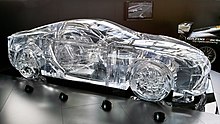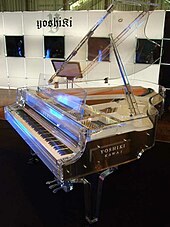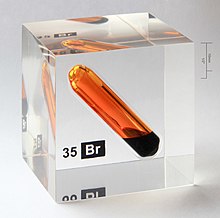Poly(methyl methacrylate)
[4] Polymethyl methacrylate was discovered in the early 1930s by British chemists Rowland Hill and John Crawford at Imperial Chemical Industries (ICI) in the United Kingdom.
During World War II both Allied and Axis forces used acrylic glass for submarine periscopes and aircraft windscreen, canopies, and gun turrets.
Notable trade names and brands include Acrylite, Altuglas,[10] Astariglas, Cho Chen, Crystallite, Cyrolite,[11] Hesalite (when used in Omega watches), Lucite,[12] Optix,[11] Oroglas,[13] PerClax, Perspex,[11] Plexiglas,[11][14] R-Cast, and Sumipex.
[17] PMMA transmits up to 92% of visible light (3 mm (0.12 in) thickness),[18] and gives a reflection of about 4% from each of its surfaces due to its refractive index (1.4905 at 589.3 nm).
Colored PMMA varieties allow specific IR wavelengths to pass while blocking visible light (for remote control or heat sensor applications, for example).
PMMA swells and dissolves in many organic solvents; it also has poor resistance to many other chemicals due to its easily hydrolyzed ester groups.
[22] The Futuro house was made of fibreglass-reinforced polyester plastic, polyester-polyurethane, and poly(methylmethacrylate); one of them was found to be degrading by cyanobacteria and Archaea.
However, the pulsed lasercutting introduces high internal stresses, which on exposure to solvents produce undesirable "stress-crazing" at the cut edge and several millimetres deep.
Even ammonium-based glass-cleaner and almost everything short of soap-and-water produces similar undesirable crazing, sometimes over the entire surface of the cut parts, at great distances from the stressed edge.
Pure poly(methyl methacrylate) homopolymer is rarely sold as an end product, since it is not optimized for most applications.
The highest quality PMMA sheets are produced by cell casting, but in this case, the polymerization and molding steps occur concurrently.
Being transparent and durable, PMMA is a versatile material and has been used in a wide range of fields and applications such as rear-lights and instrument clusters for vehicles, appliances, and lenses for glasses.
PMMA in the form of sheets affords to shatter resistant panels for building windows, skylights, bulletproof security barriers, signs and displays, sanitary ware (bathtubs), LCD screens, furniture and many other applications.
Due to its aforementioned biocompatibility, poly(methyl methacrylate) is a commonly used material in modern dentistry, particularly in the fabrication of dental prosthetics, artificial teeth, and orthodontic appliances.
Objects like insects or coins, or even dangerous chemicals in breakable quartz ampules, may be embedded in such "cast" blocks, for display and safe handling.














